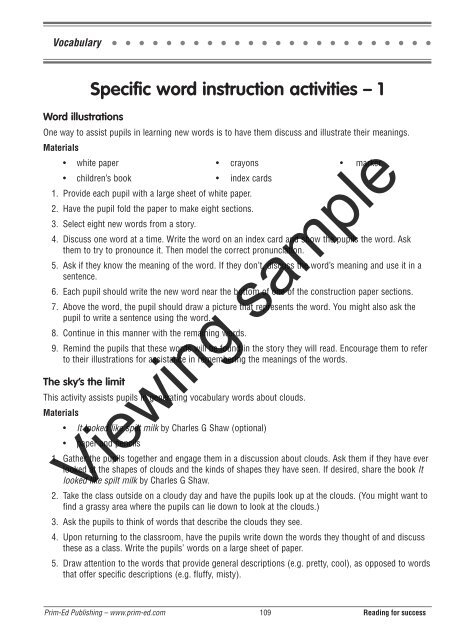PR-6218UK Reading for Success - Book 3
Create successful ePaper yourself
Turn your PDF publications into a flip-book with our unique Google optimized e-Paper software.
Vocabulary<br />
Word illustrations<br />
Specific word instruction activities – 1<br />
One way to assist pupils in learning new words is to have them discuss and illustrate their meanings.<br />
Materials<br />
• white paper • crayons • marker<br />
• children’s book • index cards<br />
1. Provide each pupil with a large sheet of white paper.<br />
2. Have the pupil fold the paper to make eight sections.<br />
3. Select eight new words from a story.<br />
4. Discuss one word at a time. Write the word on an index card and show the pupils the word. Ask<br />
them to try to pronounce it. Then model the correct pronunciation.<br />
5. Ask if they know the meaning of the word. If they don’t, discuss the word’s meaning and use it in a<br />
sentence.<br />
6. Each pupil should write the new word near the bottom of one of the construction paper sections.<br />
7. Above the word, the pupil should draw a picture that represents the word. You might also ask the<br />
pupil to write a sentence using the word.<br />
8. Continue in this manner with the remaining words.<br />
9. Remind the pupils that these words will be found in the story they will read. Encourage them to refer<br />
to their illustrations <strong>for</strong> assistance in remembering the meanings of the words.<br />
The sky’s the limit<br />
This activity assists pupils in generating vocabulary words about clouds.<br />
Materials<br />
• It looked like spilt milk by Charles G Shaw (optional)<br />
• paper and pencils<br />
1. Gather the pupils together and engage them in a discussion about clouds. Ask them if they have ever<br />
looked at the shapes of clouds and the kinds of shapes they have seen. If desired, share the book It<br />
looked like spilt milk by Charles G Shaw.<br />
Viewing sample<br />
2. Take the class outside on a cloudy day and have the pupils look up at the clouds. (You might want to<br />
find a grassy area where the pupils can lie down to look at the clouds.)<br />
3. Ask the pupils to think of words that describe the clouds they see.<br />
4. Upon returning to the classroom, have the pupils write down the words they thought of and discuss<br />
these as a class. Write the pupils’ words on a large sheet of paper.<br />
5. Draw attention to the words that provide general descriptions (e.g. pretty, cool), as opposed to words<br />
that offer specific descriptions (e.g. fluffy, misty).<br />
Prim-Ed Publishing – www.prim-ed.com 109 <strong>Reading</strong> <strong>for</strong> success


















